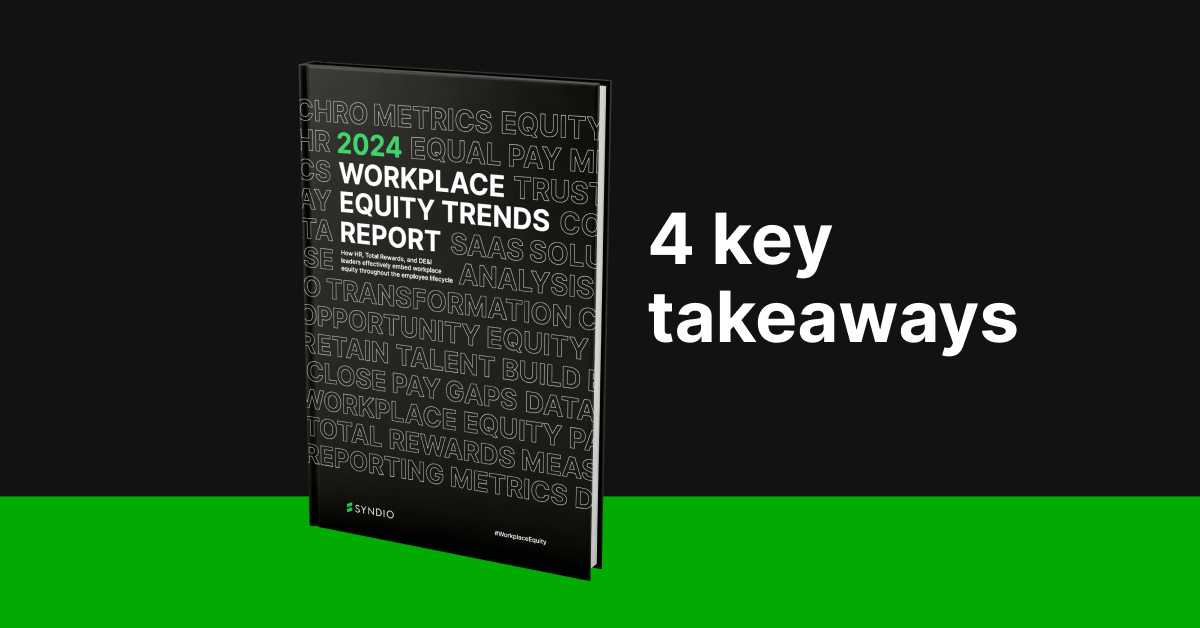As legislative demands for transparency around both pay and opportunity continue to expand globally, the call for fairness from employees grows louder. But with an increasingly volatile economy, where does workplace equity stand as a business priority in the upcoming year?
To gauge priorities and sentiment around workplace equity initiatives and HR trends, Syndio surveyed professionals and leaders primarily in HR, Total Rewards, and DE&I. The results are in — and the 2024 Workplace Equity Trend Report is out now.
In this blog, we’ll break down some big picture findings about the current state of workplace equity. For a comprehensive look at the top workplace equity trends for next year, be sure to explore the full report.
1. Workplace equity remains a priority next year, especially for enterprise companies.
The challenge: Organizations are adjusting their talent management strategies in response to increasing volatility and uncertainty in the market. Typically, growth is slowing as organizations prepare to weather potential storms with the talent and resources they have on hand — shifting HR focus to internal mobility and retention.
As companies look for ways to keep employees retained and engaged, the perception of fairness is becoming a crucial component of employer brands. For example, global analyst Josh Bersin has shared that “It isn’t the level of pay that creates employee engagement — it’s the fairness of pay” and their research shows that “your ability to demonstrate fair and equitable rewards practices is now a requirement to attract and retain hard-to-find talent.”
Driving this pressure is the fact that employees have more information about their peers’ pay and who is getting opportunities for promotion than ever before. Salary ranges are increasingly public as pay transparency laws continue to expand across the U.S. Additionally, a new set of “opportunity transparency” requirements in Colorado and Illinois, as well as in the EU Pay Transparency Directive, reflect an emerging trend calling for more transparency around opportunities for career growth.
Why this matters: Companies today are acknowledging that workplace equity is a business imperative to retain talent and comply with expanding transparency requirements. Forward-thinking companies are doubling down on workplace equity as a vital component of employer brand in a volatile market.
2. Companies lack the workplace equity metrics they need to effectively measure and communicate progress.
The challenge: HR reporting has historically centered around “soft”, qualitative measures and shallow data points, lacking a standardized set of metrics demonstrating measurable impact. This leads to an elusive understanding of progress and ineffective oversight of workplace equity initiatives by leadership and boards, as echoed in findings from the Advancing Workplace Equity from the Boardroom report from Tapestry Networks and Syndio. A key reason this has been the case is that running these analyses with traditional, out-sourced methods is time-consuming and expensive.
Why this matters: Leveraging data is crucial for companies to ensure they are aiming at realistic diversity and equity targets and can accurately forecast and track progress towards those goals. CHROs are the financial stewards of the largest item on the P&L sheet: employees. By reporting on a standardized set of HR metrics that show progress over time for pay equity, diversity, and opportunity equity, CHROs can better elevate their seat at the leadership table and get top billing in board meetings.
HR leaders should also go deeper into their data: establishing where the company stands in comparison to established benchmarks, analyzing long-term trends, identifying the root causes of inequities, and forecasting milestones for goal achievements. By investing in workplace equity analytics software, HR leaders can gain the capability to thoroughly analyze and report on these critical aspects to present to their board.
In the face of vague reporting and ambiguous targets, workplace equity and DE&I continue to be viewed as a cost center by many leaders and organizations, rather than a contributor to business performance. This misconception leads to workplace equity programs struggling to secure the necessary resources and attention. To address this, discussions surrounding workplace equity should be reframed to emphasize their impact on business and differentiation, which requires a clear connection (via data) between investments and business performance. HR leaders should aim to identify concrete links between specific workplace equity efforts and outcomes such as talent resilience, innovation, and risk mitigation.
3. Leadership buy-in and knowledge about where to focus efforts are still lacking.
The challenge: It’s rare for business leaders outside of the HR function to have a deep understanding of issues related to workplace equity. As a consequence, leaders can feel uncertain about the actions that they can take to support equity or address issues. Couple this with the lack of data discussed in section 2, and you can end up with a workplace equity program that struggles with executive buy-in – and therefore resources and attention.
The fact that most practitioners feel their leadership relies too heavily on recruitment to increase diversity demonstrates that there’s an element of education needed for leadership around the interdependent forces that contribute to pay gaps and representation gaps. While recruiting is one lever for increasing diversity, recruitment alone fails to address how internal pipeline issues such as inequitable performance reviews, promotions, and retention impact representation in management and leadership.
Why this matters: HR needs to build a better narrative around the business case for workplace equity and level-set with leaders on definitions and understanding of core workplace equity concepts. Conversations around workplace equity need to be reframed in terms of business impact and differentiation, which requires clearly connecting the dots through data between investments and business performance. HR leaders should aim to identify concrete links between specific workplace equity efforts and outcomes such as talent resilience, innovation, and risk mitigation.
4. It’s time to look at equitable outcomes beyond pay alone.
The challenge: Pay equity is a common starting point for organizations’ workplace equity journeys. This is because pay equity is entirely within a company’s control to solve through statistical analysis and remediation (as long as they have the budget to increase compensation for underpaid employees). But there are many other contributors to a company’s unadjusted pay gap beyond pay inequities. To move the needle on pay gaps, companies need to expand their focus to include analyzing and addressing opportunity inequities.
Why this matters: Every moment in the employee lifecycle — from performance reviews to promotions to attrition — is interconnected and can adversely impact workplace equity. New opportunity transparency requirements in Colorado, Illinois, and in the EU Pay Transparency Directive, as well as an increased focus on unadjusted pay gap reporting, mean that companies should start looking at equitable outcomes at more moments in the employee lifecycle beyond pay alone — particularly leading indicators like differences in performance and potential ratings between groups.
Dive into the HR trends around workplace equity
These are only a few big picture highlights from the 2024 Workplace Equity Trends Report. As you gear up for 2024 planning, check out the full report for the specific trends to prepare for next year.
The information provided herein does not, and is not intended to, constitute legal advice. All information, content, and materials are provided for general informational purposes only. The links to third-party or government websites are offered for the convenience of the reader; Syndio is not responsible for the contents on linked pages.


